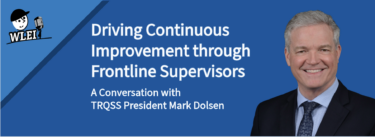I’ve spent a lot of time in recent years trying to understand how organizations can create basic stability in their daily operations through rigorous daily management, with the objective of creating a stable platform for sustainable improvement. One of my most intense efforts was repeated observation of daily management practice at Lantech while serving as the editorial advisor for Jim Lancaster’s book, The Work of Management. This volume presents what I believe is a compelling method of daily management for a relatively small manufacturing business — fewer than 500 employees with only two production facilities.
Toyota provides an alternative example, using the same basic methods in a very large manufacturing business with 364,000 employees all over the world. This organization is surely the global leader in daily management and continuous improvement targeted to support top-level hoshin objectives, as I described from direct observation in my previous Lean Post The Cascade of Hoshin.
But what about large businesses in service industries that I believe might gain even more benefit from daily management? I have seen many examples of daily huddles at the front lines in financial services, fast food and restaurants, healthcare, etc., with cumbersome attempts to aggregate the findings for higher levels of management. Until recently I had not seen anything that felt like a robust and sustainable process that created the foundation for improvement. (I’m not saying these haven’t existed, of course. It’s a big world and I can’t see everything.)
In March, at the LEI Transformation Summit in Nashville, Dr. Lisa Yerian and Nate Hurle from the Cleveland Clinic asked if I would visit to observe the daily management system they have recently helped install at the Clinic’s operations in Ohio. (12 hospitals, including the 1400 bed main campus, with the intent to involve all 53,000 employees.) (Full disclosure. I have never had any relationship with the Cleveland Clinic and I received no fee for my visit. I did ask the Clinic to pay my expenses.) I was skeptical about what I would find – I’m always skeptical about self-reports in the absence of gemba knowledge – but I agreed to visit in July.
Over the past decade the Cleveland Clinic replicated the familiar story of a large service organization taking swings at the lean piñata but with limited success. Significant focus on projects using lean methods, varying degrees of senior management enthusiasm and engagement, and modest sustainable results.
Four years ago, Lisa and Nate decided to take a more robust approach and focus on implementing systems and building capability where every caregiver was capable, empowered, and expected to make improvements every day. You can read more about their shift here.
Last year, Lisa and Nate, along with executive leaders (Dr. Tom Mihaljevic, President and CEO; Dr. K. Kelly Hancock, Executive Chief Nursing Officer; and Dr. Ed Sabanegh, President, Main Campus and Regional Hospitals), decided to take a much more systematic approach by building a daily management system that spans the organization and would expose and elevate information every morning through six levels of management, from the nurse at the bedside to the CEO. It was to be a mighty escalator (my phrase, not theirs) of operational information, including successes, challenges, opportunities to improve, and countermeasures that in typical healthcare organizations are not visible above their level of occurrence and whose resolution, even when flagged promptly, is usually delegated horizontally to staff for attention over extended periods. Hence, challenges persist, and too many remain unresolved.
Today every organization faces great challenges, major disruption and, in consequence, the need for much more effective hoshin. So there is a healthy urgency to link daily management, targeted kaizen, and focused hoshin for organizational survival.
I visited Cleveland in July to see this system in action by taking a ride on the escalator from start to finish. A typical day looks like this: The first huddles begin at 7 am with every manager meeting with his or her team (ie, nurse manager with bedside nurses on an inpatient unit). This leads to a later meeting (typically around 8am) of the managers with their director, the 9:15 meeting of all directors with the hospital chief nursing officer (for the nursing teams) or operating officer (for operational functions), the 9:45 meeting with the leaders of the hospital, the 10:15 meeting of leaders from each of the 12 hospitals and the executive clinical leaders, and the 11 am meeting with the CEO, clinical leaders, and other members of the operations council including the executive leaders of the major functions from Quality and Patient Experience to IT, HR and Operations. At each level’s meeting the issues from below are elevated and aggregated as the meeting participants see and assess the performance of a larger and larger slice of the total system.
But that’s just the formal structure. The key to making the escalator useful is to determine actual performance the preceding day at every level and flag abnormal or unacceptable performance at that level. These issues are written by the line manager on the right side of the dry-erase management boards for special attention and rapid countermeasures. (If line managers at each level cannot respond to problems quickly, their reports will soon conclude that the whole exercise is only about drawing up problem lists – a bad tendency of bureaucracies in general and many visual management systems in particular. And they will lose interest.)
Once issues are flagged, the question becomes whether they can be resolved by managers in that unit or whether they need to be shared with adjacent units. For example, I observed at the second level meeting that the managers described challenges within their individual units – which may be related to patient needs, staffing, and equipment, among others — and asked the other units if they could help, with a bit of coaching from the director the unit managers reported to. Decisions to make the day better for patients and caregivers were made in just a few minutes with no back and forth e-mail or additional meetings required.
There is a second type of issue that can only be addressed by elevating (escalating) it to a higher level huddle for discussion and resolution. And a few ride the escalator all the way to the top for a rapid decision. For example:
What to do about the patient from another country, who has no family to care for him in the U.S. and who has been diagnosed with a fatal condition requiring hospice? Answer: Work with the embassy, transportation, and others to safely reunite the patient with the family. (But highlight this issue if it recurs and needs more detailed analysis and a formal policy.)
And what to do about the patient who was discharged and then asked to come back for a procedure, but given the wrong time to return by the automated scheduling system – 6 am rather than 1 pm, meaning an all-day wait in the hospital? Answer: Ask if any of the other hospitals have had this problem and, if the answer turns out to be “yes” (meaning it’s an IT system problem), give the responsibility for the problem to the head of IT (who attends the top-level meeting) with an agreed date for a report back on a permanent countermeasure. Two problems addressed in a few minutes with no e-mail by escalating them quickly to the right level! What the world needs now. Especially in healthcare.
It’s still early days for daily management at the Cleveland Clinic. The first CEO level huddle occurred April 30, and most hospitals started in May. But with the system in place in the Ohio hospitals (and slated for introduction in outpatient practices in Ohio and at other Cleveland Clinic campuses in Florida) it’s a good time to ask what the benefits of daily management have proved to be. Perhaps only 10% of the benefit occurs at the top level where unique challenges can be addressed quickly and where big trends within the organization – staff engagement, falls, infections, etc. – can be spotted and addressed early.
The bulk of the benefit is that performance on every metric is reported daily for the day before at every level and most problems are dealt with at that level by line managers in real time. This gives caregivers the sense that managers are really paying attention, that their challenges really are being understood and addressed, and that over time this will mean stability, a lower level of stress for all staff and an improved patient experience. It also should mean that line-managers in the future will face less daily chaos and have more time for permanently countermeasuring problems and improving performance.
But these achievements also surface problems, the most notable being that many line managers still struggle to distinguish between the need for containing problems (with quick countermeasures) and the need for root cause analysis. And they struggle to conduct rigorous root cause investigations under their leadership rather than delegating problems to the improvement and quality staffs. More problem-solving practice for managers, with coaching from the improvement team, is in the plan but creating the necessary skills will be a long-term process. (Remember that most nurses and practically all doctors have completed their formal medical education without attention to the processof medicine and training in solving process problems. Their training focuses instead on the discrete care-giving practices of medicine.)
The next challenge will then be to create a robust kaizen process for improving end-to-end processes rather than local ones (e.g., better utilization of operating rooms, better coordination of patient journeys across organizational boundaries) and to target these improvements to top-level hoshin (strategic planning) objectives.
This last leap is a great challenge for every organization but the healthcare industry, like many others at this point in history, faces major disruption and in consequence the need for much more effective hoshin. So there is a healthy urgency to link daily management, targeted kaizen, and focused hoshin for organizational survival.
At the end of my visit I could say with relief that the Cleveland Clinic has made a great start facing these challenges. I look forward to returning someday soon when all of the elements of lean management are in place to take another fun ride on the escalator of issues.
The Lean Management Program
Build the capability to lead and sustain Lean Enterprises






